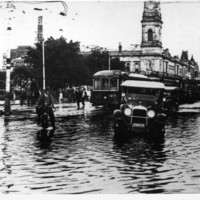Subject
ContributeBecause of the need for agricultural self-sufficiency European settlement in Australia was heavily based on the assumption of favourable climates. Yet preparations for settlement in South Australia involved an almost impertinent sense of boldness considering the actual settlement location had not been identified before the first pioneers sailed.
The 1802 voyage of Captain Matthew Flinders, who along with Nicolas Baudin explored the remaining uncharted coastline of Australia, drew attention to this region. For nineteenth-century Europeans most of the unclaimed coastline of southern Australia, with the exception of the Fleurieu Peninsula, cannot have appeared inviting or hospitable. Motivated by the long European search for lush vegetation on Terra Australis, it is little wonder that the dark green hills of the Mount Lofty Ranges and the stately red gum dotted parkland of the plains east of Gulf St Vincent left a favourable impression on Flinders and his companions.
In 1836 Colonel William Light was able to compare the merits of Kangaroo Island, Port Lincoln and Rapid Bay areas within a few weeks deciding in favour of plains flanking the foot of Mount Lofty. Light identified the coastal lagoon connecting the Patawalonga and Port River estuaries and the dangers of periodic flooding under a climatic regime that he correctly identified as being Mediterranean, in which most rain falls during winter. Mindful of the hydrological warning offered by extensive reedbeds, Light chose to locate the future city of Adelaide on the first elevational step where the River Torrens was confined to a well defined broad valley.
The accompanying maps offer an overview of South Australia’s climatic characteristics and also explain the manner in which settlement spread from Adelaide. Each of the three rainfall attributes is strongly influenced by three factors: southerly latitude, proximity to the coastline, and elevation in the Mount Lofty–Flinders Ranges. The uplifting influence of the Ranges on winter airflow from the south west is clearly seen in the distribution of mean annual rainfall. Even the hardiest cereal crops cannot thrive on less than 300 mm, hence this contour delineates the limits of the state’s unirrigated agriculture while verifying George Goyder’s astute observations about the limits of arable land. The map of rainfall reliability helps explain the consequences of Goyder’s cautionary words, ignored in times of climatic optimism. The contours of summer to winter rainfall reveal that near the coast and ranges most rain falls in winter, when it is required by cereal crops.
The same factors that control rainfall characteristics also influence air temperatures. January maxima are such that the preference for coastal or hill-top living is unsurprising, with summer benefits realised by nineteenth century governors. In the absence of clouds, strong solar irradiance tends to generate uniform surface temperatures over South Australia’s modest range of altitudes, where differences in maximum air temperatures are often less evident than those observed between land and sea. The effect of the latter is most evident in the minimum July temperatures, which, however, also reveal the cold pool of air that can settle just east of the Ranges.
Climatic considerations are integral to understanding natural as well as economic environments. Intelligent use of plants and siting of buildings can minimise the cost of both maintenance and thermal comfort. The annual mean temperature, about 17°C in Adelaide, prevails in deep cellars, almost ideal for ageing wine. The sun, wind and rain are all nature’s gifts, of which only the latter has been effectively realised. Wiser counsel in future may yet see the winning of the state’s greatest inland resource – solar energy – and its great coastal asset – the wind – being harnessed for renewable power.
Media
Add mediaImages

Image courtesty of State Library of South Australia, SLSA: B 54330, Public Domain

Image courtesy of State Library of South Australia, SLSA: PRG 1364/1/58, Public Domain

Image courtesy of State Library of South Australia, SLSA: B 60616, Public Domain


CommentAdd new comment
Quickly, it's still quiet here; be the first to have your say!